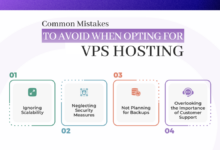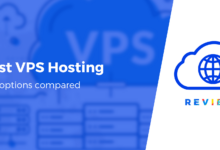Top 10 Benefits of VPS Hosting for Your Business in 2025
Top 10 Benefits of VPS Hosting for Your Business in 2025: In today’s dynamic business landscape, choosing the right hosting solution is paramount for success. A Virtual Private Server (VPS) offers a compelling blend of performance, security, and scalability, making it an increasingly attractive option for businesses of all sizes in 2025. This exploration delves into the top ten advantages of VPS hosting, illuminating how it can significantly enhance your online presence and operational efficiency.
This guide will examine key benefits, including enhanced performance and speed, increased security and control, scalability and flexibility, cost-effectiveness, and improved reliability. We’ll also explore how VPS hosting empowers better resource allocation, customization, and support for demanding business applications, ultimately fostering greater flexibility for future growth and improved SEO performance. By understanding these advantages, businesses can make informed decisions to optimize their online infrastructure and achieve their strategic goals.
Enhanced Performance and Speed
VPS hosting offers a significant performance advantage over shared hosting, leading to faster website loading times and improved user experience. This is crucial in today’s fast-paced digital world, where users expect immediate results. A sluggish website can lead to lost customers and negatively impact your business’s bottom line.
The improved speed is primarily due to the dedicated resources allocated to each VPS. Unlike shared hosting, where multiple websites share the same server resources, a VPS provides a virtualized server environment with its own dedicated CPU, RAM, and storage. This isolation ensures that your website isn’t affected by the performance of other websites on the same server.
Impact of Server Resources on Website Performance
The amount of CPU, RAM, and storage allocated to your VPS directly impacts your website’s performance. A higher CPU allocation allows for faster processing of requests, while more RAM enables the server to handle more concurrent users without slowing down. Sufficient storage ensures that your website’s files and databases are readily accessible. For instance, an e-commerce website with a large product catalog and high traffic volume would benefit greatly from a VPS with substantial CPU, RAM, and storage to handle the increased processing demands and database queries. Conversely, a small business blog with low traffic might only require a modest allocation of these resources. The key is to select a VPS plan that aligns with your website’s current and projected needs.
Examples of Businesses Benefiting from Faster Website Speeds
E-commerce businesses, such as online retailers selling clothing or electronics, see a direct correlation between website speed and sales conversions. Faster loading times lead to increased customer satisfaction and reduced bounce rates. Similarly, online news publications benefit from improved speed to deliver timely information to their audience. A slow-loading news website might lose readers to competitors with faster sites. Finally, SaaS companies providing online software applications rely on fast-loading websites to ensure a seamless user experience for their subscribers. Slow loading times can lead to frustrated users and churn.
Comparison of Website Loading Times
The following table illustrates the hypothetical difference in website loading times between shared hosting and VPS hosting. These are illustrative examples and actual performance will vary depending on various factors including website complexity, server load, and network infrastructure.
| Hosting Type | Average Load Time (seconds) | Number of Users (concurrent) | Website Size (MB) |
|---|---|---|---|
| Shared Hosting | 3.5 | 50 | 100 |
| VPS Hosting | 1.2 | 150 | 100 |
Increased Security and Control
VPS hosting offers a significant leap in security and control compared to shared hosting environments. Unlike shared hosting where multiple websites share the same server resources, VPS hosting provides each user with a virtualized server, isolating them from other users and their potential security vulnerabilities. This isolation drastically reduces the risk of compromise stemming from the actions or negligence of other users on the server.
The inherent security benefits of VPS hosting are further enhanced through robust security practices. Effective security management requires a proactive approach encompassing various layers of protection.
Firewall Configuration
A properly configured firewall acts as the first line of defense, selectively allowing or blocking network traffic based on predefined rules. This prevents unauthorized access attempts and protects the server from malicious activities. Implementing a robust firewall involves defining specific rules to permit only necessary inbound and outbound connections, effectively creating a barrier against unwanted intrusions. For instance, blocking all inbound connections except for SSH (for secure remote access) and HTTP/HTTPS (for web traffic) significantly reduces the attack surface. Regularly reviewing and updating firewall rules is crucial to maintain optimal security.
Software Updates and Patch Management
Regular software updates are essential for patching known vulnerabilities and mitigating potential security risks. Outdated software is a prime target for attackers, often containing exploitable flaws. A systematic approach to software updates, including operating system updates, application updates, and security patches, is vital for maintaining a secure VPS. Implementing automated update mechanisms can streamline this process, ensuring that the server is always running the latest secure versions of software. For example, utilizing a package manager like apt (for Debian/Ubuntu) or yum (for CentOS/RHEL) allows for efficient and automated updates.
Root Access and Server Security Management
Root access provides complete control over the VPS server, granting the user the ability to manage all aspects of the server’s configuration and security. This level of control is crucial for implementing comprehensive security measures. However, root access also carries significant responsibility. Misconfiguration or negligence can severely compromise server security. Best practices for managing root access include using strong passwords, employing SSH key authentication instead of password-based authentication, and regularly auditing server logs to detect any suspicious activity. Implementing a principle of least privilege, where users only have the necessary access rights for their tasks, is also vital to mitigate the risks associated with root access.
Visual Representation of VPS Security Layers
Imagine a series of concentric circles representing security layers.
* Outermost Circle: Firewall: This acts as the first barrier, filtering network traffic based on predefined rules.
* Second Circle: Intrusion Detection/Prevention System (IDS/IPS): Monitors network traffic for malicious activity and takes action to block or alert on suspicious events.
* Third Circle: Operating System Security Hardening: Includes secure configuration of the operating system, regular updates, and the disabling of unnecessary services.
* Innermost Circle: Application-Level Security: Secure coding practices, regular updates of applications, and input validation to prevent vulnerabilities.
This layered approach provides a robust defense against various threats, significantly improving the overall security of the VPS.
Scalability and Flexibility
One of the most compelling advantages of VPS hosting is its inherent scalability and flexibility. Unlike shared hosting, where resources are limited and shared among multiple users, a VPS provides dedicated resources that can be easily adjusted to meet the fluctuating demands of your business. This adaptability is crucial for businesses experiencing growth or seasonal changes in traffic.
VPS hosting allows for seamless scaling, both vertically and horizontally. Vertical scaling involves upgrading the resources allocated to your existing VPS, such as increasing RAM, CPU power, or storage space. Horizontal scaling, on the other hand, involves adding more VPS instances to distribute the workload across multiple servers. This ensures your website or application remains responsive and performs optimally even during periods of high traffic.
VPS Resource Upgrades
Upgrading resources on a VPS is typically a straightforward process. Most VPS providers offer user-friendly control panels that allow you to easily adjust your server’s configuration. For instance, you might use a web-based interface to select a higher RAM option, a more powerful CPU, or a larger storage capacity. The exact steps may vary depending on your provider, but generally involve accessing your control panel, selecting your VPS, and choosing the desired resource upgrade. The provider will then provision the updated resources, and your VPS will be rebooted to implement the changes. Downtime is usually minimal, often lasting only a few minutes. The cost of the upgrade will typically reflect the increased resource allocation.
Scaling a VPS Based on Traffic Patterns
Effective scaling requires monitoring your website’s traffic patterns to anticipate and address potential resource constraints. A systematic approach is key.
- Traffic Monitoring: Regularly monitor your website traffic using analytics tools like Google Analytics. Identify peak usage times and periods of high traffic volume, such as during seasonal sales or marketing campaigns. This data will help you predict future resource needs.
- Resource Analysis: Analyze your server resource utilization during peak traffic periods. Check CPU usage, RAM consumption, and disk I/O to determine which resources are becoming bottlenecks. This data will guide your scaling decisions.
- Proactive Scaling: Instead of reacting to performance issues after they occur, proactively scale your VPS resources *before* you anticipate a surge in traffic. This ensures a smooth user experience and avoids downtime.
- Incremental Scaling: Avoid drastic resource changes. Start with smaller upgrades and gradually increase resources as needed. This allows you to fine-tune your server configuration and optimize performance without unnecessary expense.
- Post-Scaling Analysis: After scaling, monitor your server’s performance to ensure the upgrades have resolved the bottleneck and improved overall performance. This feedback loop helps refine your scaling strategy for future events.
For example, an e-commerce business might experience a significant increase in traffic during the holiday shopping season. By proactively scaling their VPS resources (adding more RAM and CPU) before the peak season, they can ensure their website remains responsive and capable of handling the increased order volume, preventing lost sales due to slow loading times or server crashes. Conversely, a business with lower traffic during the off-season could downsize its VPS to reduce costs, demonstrating the flexibility offered by this type of hosting.
Cost-Effectiveness
VPS hosting presents a compelling value proposition for businesses seeking a balance between performance, control, and affordability. Unlike shared hosting, which pools resources and can lead to performance bottlenecks, or dedicated servers, which often involve significant upfront investment and ongoing management costs, VPS hosting offers a middle ground that can be remarkably cost-effective.
VPS hosting allows businesses to pay only for the resources they need, avoiding the unnecessary expense of a full dedicated server. This is particularly advantageous for businesses experiencing moderate to high traffic, but not yet requiring the full capacity and associated costs of a dedicated server. This scalable nature means businesses can upgrade their resources as their needs grow, avoiding the potential waste of unused resources inherent in a dedicated server approach.
VPS Hosting Cost Compared to Other Options
VPS hosting generally sits between shared and dedicated hosting in terms of cost. Shared hosting is the most affordable, but offers the least control and performance. Dedicated servers are the most expensive, providing maximum control and resources but at a substantial cost. A VPS strikes a balance. For example, a small business might find a shared hosting plan sufficient initially, but as their website traffic increases and they require more resources, such as higher RAM and processing power, upgrading to a VPS would be far more cost-effective than immediately jumping to a dedicated server. Similarly, a large enterprise already using a dedicated server might find that certain less-critical applications or projects could run efficiently and economically on a VPS, rather than consuming the resources of the more expensive dedicated environment.
Cost-Saving Benefits of Efficient Resource Management
One of the significant advantages of VPS hosting is the ability to efficiently manage your own server resources. Unlike shared hosting where resources are shared and potentially impacted by other users, a VPS provides dedicated resources within a virtualized environment. This allows for optimized resource allocation. For instance, a business can allocate more RAM to applications demanding high performance, while assigning less to less critical tasks. This fine-grained control leads to better performance and reduced resource waste, directly impacting the overall cost-effectiveness of the solution. By monitoring resource usage and adjusting allocations as needed, businesses can minimize unnecessary expenditure on resources they don’t require, leading to significant cost savings over time.
Cost Comparison Table
| Hosting Type | Monthly Cost (USD, Estimate) | Resource Allocation | Scalability |
|---|---|---|---|
| Shared Hosting | $5 – $25 | Shared CPU, RAM, and storage | Limited |
| VPS Hosting | $20 – $100+ | Dedicated virtual resources (CPU, RAM, storage) | High – easily upgradeable |
| Dedicated Server | $100+ | Entire physical server dedicated to one user | Requires reconfiguration or new server |
Reliability and Uptime
VPS hosting offers significantly improved reliability and uptime compared to shared hosting, contributing to a more stable and efficient business operation. This enhanced reliability stems from the dedicated resources and isolated environment provided by a VPS.
The factors contributing to higher uptime with VPS hosting are numerous. Unlike shared hosting, where resources are shared among multiple websites, a VPS provides dedicated server resources. This isolation prevents performance issues on one website from impacting others. Furthermore, VPS providers typically offer advanced monitoring and management tools, enabling quicker response times to potential issues. The ability to control the server environment also allows for proactive maintenance and optimization, reducing the likelihood of downtime.
Impact of High Uptime on Business Operations and Customer Satisfaction
High uptime is directly correlated with increased business productivity and improved customer satisfaction. Consider an e-commerce business: even a few hours of downtime can result in significant lost sales and frustrated customers. High uptime ensures continuous accessibility, enabling seamless operations and fostering customer loyalty. For businesses reliant on real-time data processing or online transactions, consistent availability is crucial for maintaining competitive advantage and operational efficiency. For example, a financial institution relying on a website for online banking must maintain exceptionally high uptime to avoid significant financial and reputational damage. Conversely, consistent uptime builds trust and confidence, encouraging repeat business and positive word-of-mouth referrals.
Server Monitoring and Maintenance for High Uptime
Regular server monitoring and proactive maintenance are essential for maintaining high uptime. Comprehensive monitoring systems track key performance indicators (KPIs) such as CPU usage, memory consumption, disk space, and network traffic. Automated alerts notify administrators of potential issues before they escalate into outages. Proactive maintenance includes regular software updates, security patches, and backups to mitigate risks and ensure system stability. This preventative approach minimizes the likelihood of unexpected downtime and allows for timely resolution of any problems that do arise. For instance, a scheduled system reboot to apply crucial security patches, while causing temporary downtime, prevents potential vulnerabilities that could lead to a far more extensive outage later.
Ensuring Server Reliability and Uptime: A Flowchart
The following flowchart illustrates the steps involved in ensuring server reliability and uptime:
[Diagram Description: The flowchart begins with a “Start” box. This is followed by a decision box: “Is the server monitored?”. If yes, the flow continues to a box labeled “Regular Monitoring and Alerting”. If no, the flow goes to a box labeled “Implement Monitoring System”. From “Regular Monitoring and Alerting”, the flow continues to a decision box: “Are there any alerts?”. If yes, the flow goes to a box labeled “Investigate and Resolve Issues”. If no, the flow continues to a box labeled “Proactive Maintenance (Updates, Backups)”. From both “Investigate and Resolve Issues” and “Proactive Maintenance”, the flow converges to a box labeled “Regular System Checks”. Finally, the flow ends with an “End” box. The entire process is cyclical, indicating ongoing monitoring and maintenance.]
Improved Resource Allocation
A Virtual Private Server (VPS) offers a significant advantage over shared hosting through its dedicated allocation of resources. Unlike shared hosting where resources are divided among multiple users, a VPS provides each user with a private slice of the server’s resources, guaranteeing consistent performance regardless of other users’ activity. This dedicated access translates to predictable performance, crucial for businesses relying on their online presence for operations.
The dedicated allocation of resources within a VPS environment directly impacts website responsiveness and application performance. For example, a website hosted on a shared server might experience slow loading times during peak hours due to resource contention with other websites on the same server. A VPS, however, provides a guaranteed amount of CPU, RAM, and I/O, ensuring consistent loading speeds even under high traffic. Similarly, resource-intensive applications, such as e-commerce platforms or CRM systems, benefit significantly from the dedicated resources of a VPS, leading to smoother operation and improved user experience. A poorly performing e-commerce site, for instance, can directly impact sales and customer satisfaction. A VPS mitigates this risk.
VPS Resource Usage Monitoring
Monitoring resource usage is crucial for maintaining optimal VPS performance. Most VPS providers offer control panels that provide real-time insights into CPU usage, RAM consumption, and I/O operations. These panels typically display graphs and charts showing resource usage over time, allowing administrators to identify potential bottlenecks or resource exhaustion. For example, consistently high CPU usage might indicate the need for an upgrade to a more powerful VPS plan, while high RAM consumption could suggest an application memory leak that needs to be addressed. Regular monitoring allows for proactive adjustments, preventing performance degradation. Many providers also offer email alerts for critical resource thresholds, ensuring timely intervention.
Best Practices for VPS Resource Allocation Optimization
Effective resource allocation is essential for maximizing the benefits of a VPS. The following best practices contribute to optimal performance and efficient resource utilization.
- Regularly monitor resource usage to identify potential bottlenecks and proactively address them.
- Optimize website code and applications to minimize resource consumption. This includes using caching mechanisms, compressing images, and minimizing database queries.
- Choose the appropriate VPS plan based on your anticipated resource needs. Avoid over-provisioning, which is unnecessarily expensive, and under-provisioning, which can lead to performance issues.
- Implement robust security measures to prevent unauthorized access and resource consumption by malware or malicious actors. This includes regular security updates and the use of firewalls.
- Utilize caching technologies such as Varnish or Redis to reduce the load on your web server and database.
- Regularly back up your VPS data to prevent data loss and ensure business continuity.
Enhanced Customization and Control
VPS hosting offers a level of control and customization unmatched by shared hosting environments. This granular control empowers businesses to optimize their server resources and tailor their online presence to their specific needs, leading to improved performance, security, and overall efficiency. The ability to fine-tune every aspect of your server environment is a significant advantage for businesses seeking maximum flexibility and performance.
The primary advantage stems from root access, granting complete administrative privileges over the virtual server. This differs significantly from shared hosting where users have limited access and control. With root access, businesses can manage every aspect of their server’s software and hardware, installing and configuring applications, adjusting system settings, and managing security protocols with unparalleled precision.
Customization Options Available with VPS Hosting
The flexibility offered by VPS hosting is substantial. Businesses can install and configure any software compatible with their chosen operating system. This includes web servers like Apache or Nginx, databases such as MySQL or PostgreSQL, programming languages like Python or PHP, and countless other applications needed for a wide range of business operations. For example, a business might install specific security software tailored to their needs, or configure a custom firewall to enhance their security posture. They could also install and configure specific monitoring tools to gain granular insight into their server’s performance. Another example is the ability to fine-tune the server’s resource allocation to prioritize specific applications or services.
Operating System and Software Stack Selection
VPS hosting provides the freedom to choose your preferred operating system (OS) and software stack. This is a critical differentiator from shared hosting, where the OS and software are typically pre-configured and cannot be changed. Popular choices for VPS operating systems include various Linux distributions (like Ubuntu, CentOS, Debian) and Windows Server. The ability to select an OS aligned with your technical expertise and application requirements is a significant advantage. The choice of software stack, encompassing the web server, database, and programming languages, can be tailored to optimize performance and compatibility with specific applications and frameworks. For instance, a business heavily reliant on a specific PHP framework might choose an OS and software stack optimized for that framework.
Comparison of Customization Options: VPS vs. Shared Hosting
| Feature | VPS Hosting | Shared Hosting |
|---|---|---|
| Root Access | Yes, full control | No, limited access |
| Operating System Choice | Wide range of options (Linux distributions, Windows Server) | Fixed, pre-configured OS |
| Software Installation | Complete freedom to install any compatible software | Limited to pre-installed software or applications approved by the hosting provider |
| Server Configuration | Full control over server settings and configurations | No control over server-level configurations |
| Customization Level | Highly customizable | Limited customization |
Better Support for Business Applications
VPS hosting offers significant advantages over shared hosting for businesses running demanding applications. The dedicated resources and enhanced control provided by a VPS ensure optimal performance, stability, and security, crucial for mission-critical business applications. Unlike shared hosting where resources are divided among multiple websites, a VPS provides a virtualized server environment with its own dedicated resources, preventing performance bottlenecks and ensuring consistent application responsiveness.
VPS hosting provides a more robust and predictable environment for resource-intensive business applications. This is achieved through dedicated RAM, processing power, and storage, eliminating the competition for resources often experienced in shared hosting environments. This dedicated allocation allows applications to perform optimally, leading to improved efficiency and productivity for the business.
Application Examples and Performance Improvements
Several business applications benefit greatly from the resources and control offered by VPS hosting. For example, e-commerce platforms, with their need for high traffic handling and database management, experience significantly improved speed and stability on a VPS. Customer Relationship Management (CRM) systems, often requiring substantial processing power and data storage, benefit from the dedicated resources, leading to faster response times and improved user experience. Similarly, enterprise resource planning (ERP) systems, which integrate various business processes, can run smoothly and efficiently on a VPS, ensuring data integrity and operational effectiveness. The performance improvements seen are directly related to the dedicated resources and control; businesses often report a reduction in loading times, improved database response, and enhanced overall application stability when migrating from shared to VPS hosting.
Business Application Suitability for VPS Hosting
The following table categorizes different business applications based on their resource requirements and suitability for VPS hosting, illustrating the performance impact.
| Application Type | Resource Requirements | VPS Suitability | Performance Impact |
|---|---|---|---|
| E-commerce Platform (e.g., Magento, Shopify Plus) | High RAM, Processing Power, Database Capacity, High Bandwidth | Highly Suitable | Improved loading speed, enhanced transaction processing, increased uptime, better scalability for peak traffic. |
| CRM System (e.g., Salesforce, HubSpot) | Moderate to High RAM, Processing Power, Database Capacity | Suitable | Faster data retrieval, improved user response times, enhanced system stability. |
| ERP System (e.g., SAP, Oracle) | High RAM, Processing Power, Database Capacity, Significant Storage | Highly Suitable | Improved data processing speed, enhanced system responsiveness, better integration of business processes. |
| Content Management System (CMS) (e.g., WordPress for large websites) | Moderate RAM, Processing Power, Database Capacity | Suitable | Faster page loading, improved website performance, enhanced security. |
| Custom Business Applications | Varies greatly depending on application complexity | Highly Dependent on Application Requirements | Performance gains are directly proportional to resource allocation; a well-configured VPS can dramatically improve performance. |
Isolation from Other Users
In the bustling digital world, your website’s performance can be significantly impacted by the activities of others sharing the same server resources. VPS hosting offers a crucial advantage by isolating your resources, ensuring your website isn’t bogged down by the actions of other users. This isolation translates to a more stable, predictable, and ultimately, more successful online presence for your business.
Resource contention, a common problem in shared hosting environments, occurs when multiple websites compete for limited server resources like CPU, RAM, and bandwidth. Imagine a scenario where one website on a shared server experiences a sudden surge in traffic, consuming a large portion of available resources. This can lead to slow loading times, application errors, and even complete website outages for other websites sharing the same server. This domino effect can severely damage your business’s reputation and bottom line.
Resource Contention in Shared Hosting Environments
The impact of resource contention is directly proportional to the number of websites sharing the server and their resource demands. For example, a shared hosting environment hosting hundreds of websites, each with varying levels of traffic and resource consumption, is prone to significant performance fluctuations. If one website experiences a peak in traffic, it can significantly impact the performance of other websites on the same server. This is particularly true for resource-intensive applications such as e-commerce platforms or content management systems managing large databases. Even seemingly small actions, like a large database update on one site, can cause noticeable lag for others.
Dedicated Resources Prevent Performance Degradation
VPS hosting mitigates these issues by providing each user with a dedicated portion of server resources. This dedicated allocation guarantees a minimum level of resources, ensuring consistent performance regardless of the activity on other virtual servers within the same physical server. Unlike shared hosting, where resources are dynamically allocated and can be depleted by other users, VPS hosting provides a predictable and controlled environment. This predictability allows businesses to accurately forecast performance and plan for future growth.
Comparison of Resource Allocation: Shared Hosting vs. VPS Hosting
| Feature | Shared Hosting | VPS Hosting |
|---|---|---|
| Resource Allocation | Shared amongst multiple users; resources are dynamically allocated and can fluctuate. | Dedicated resources allocated to each user; resources are guaranteed and more stable. |
| Performance | Can be unpredictable; performance may degrade due to resource contention from other users. | More predictable and consistent performance; less susceptible to the actions of other users. |
| Security | Vulnerable to security breaches affecting other users on the same server. | Enhanced security due to isolation from other users; provides greater control over security settings. |
| Cost | Generally less expensive upfront. | More expensive than shared hosting but offers better value for money in the long run due to improved performance and reliability. |
Greater Flexibility for Future Growth
VPS hosting offers unparalleled adaptability, making it an ideal solution for businesses anticipating expansion. Unlike shared hosting, where resources are limited and scaling is difficult, VPS provides the flexibility to adjust resources on demand, ensuring your website or application can handle increased traffic and data without performance degradation. This scalability translates directly into smoother business growth and a reduced risk of service disruptions during periods of high demand.
VPS hosting allows for easy scaling to accommodate business expansion through several key mechanisms. Businesses can seamlessly adapt their VPS to handle increased traffic and data by adding more resources or upgrading to a larger VPS instance. This adaptability is crucial for businesses experiencing rapid growth, seasonal peaks in demand, or unexpected surges in website traffic. For example, an e-commerce business anticipating a holiday sales rush can proactively increase its VPS resources (RAM, CPU, storage) to ensure its website remains responsive and capable of processing a higher volume of transactions. Similarly, a rapidly growing SaaS company can scale its VPS infrastructure to support an expanding user base and data storage needs without experiencing downtime or performance issues.
Resource Allocation and Upgrades
Adding more resources or upgrading to a larger VPS instance is typically a straightforward process. Most VPS providers offer user-friendly control panels allowing users to adjust RAM, CPU, storage, and bandwidth with just a few clicks. This can often be done instantly, or within a short timeframe, minimizing any disruption to services. For instance, a business might start with a smaller VPS instance and then, as traffic increases, add more RAM to improve responsiveness, or increase storage capacity to accommodate growing data volumes. Upgrading to a larger instance involves migrating the existing data and configuration to a more powerful server with greater resources. This process is often simplified by the provider’s tools and support.
Planning for Future Growth with VPS Hosting
A well-defined plan is crucial to leverage the scalability of VPS hosting effectively. This plan should encompass several key steps:
- Assess Current and Projected Needs: Begin by carefully analyzing your current website or application’s resource consumption. Track metrics like CPU usage, RAM usage, disk I/O, and bandwidth consumption. Project these needs into the future, considering anticipated growth in website traffic, data volume, and application complexity. For example, if your website currently receives 10,000 visitors per day and you anticipate a 50% increase within the next year, your plan should account for this increase in traffic.
- Choose a Scalable VPS Provider: Select a VPS provider that offers flexible scaling options and a range of instance sizes. Look for providers with clear pricing structures and straightforward upgrade paths. Read reviews and compare different providers to ensure you choose one that meets your needs and budget.
- Implement Monitoring and Alerting: Set up monitoring tools to track your VPS’s resource usage in real-time. Configure alerts to notify you if resource consumption exceeds predefined thresholds. This allows for proactive scaling before performance issues arise. For example, if your CPU usage consistently reaches 90%, you can proactively upgrade to a VPS instance with more processing power.
- Develop a Scalability Strategy: Determine how you will scale your VPS resources in response to different growth scenarios. This might involve adding more RAM, upgrading to a larger instance, or implementing load balancing across multiple VPS instances. Having a clear strategy ensures you can respond effectively to unexpected surges in demand.
- Regularly Review and Adjust: Regularly review your VPS resource usage and your scalability plan. Adjust your plan as your business grows and your needs evolve. This ensures your VPS infrastructure remains optimized for performance and cost-effectiveness.
Improved SEO Performance (Indirectly)
While VPS hosting doesn’t directly manipulate search engine algorithms, its impact on website performance significantly influences search engine optimization (SEO) results. Faster loading speeds, higher uptime, and improved resource allocation, all benefits of VPS hosting, contribute to a better user experience and ultimately, higher search engine rankings. Search engines prioritize websites that offer a smooth and efficient experience for visitors.
VPS hosting contributes to improved SEO performance by directly enhancing factors that search engines heavily weigh. Specifically, faster loading times and consistent uptime are key elements that positively affect search engine rankings and overall website visibility. A well-optimized website hosted on a robust VPS server creates a positive feedback loop, attracting more users, increasing engagement, and boosting search rankings organically.
Faster Loading Times and Search Engine Rankings
Website speed is a critical ranking factor for major search engines like Google. Slow loading times lead to high bounce rates (users leaving the site quickly) and negatively impact user experience. VPS hosting, with its dedicated resources, significantly reduces loading times compared to shared hosting environments. A faster website translates to improved user experience, encouraging longer visits and increased engagement, signals that search engines recognize and reward with higher rankings. For example, a website consistently loading in under 2 seconds will likely outperform a similar website loading in 5 seconds, all other factors being equal. This improved speed directly contributes to better search engine rankings.
Website Uptime and User Engagement
Consistent website uptime is equally crucial for SEO success. Downtime frustrates users, resulting in lost traffic and negatively impacting search engine rankings. VPS hosting offers significantly improved uptime compared to shared hosting due to its dedicated resources and increased control over server maintenance. A website with 99.9% uptime indicates reliability and trustworthiness, enhancing user engagement and positively influencing search engine algorithms. Conversely, frequent downtime can severely damage a website’s reputation and its search engine ranking. A study by Google showed that even a few seconds of downtime can lead to a measurable decrease in organic traffic. This emphasizes the vital role of reliable hosting in achieving optimal SEO performance.
The Correlation Between Website Speed and SEO Performance
The relationship between website speed and SEO performance is strongly positive and well-documented. Search engines prioritize websites that provide a fast and efficient user experience. Studies have consistently shown a strong correlation between faster loading times and improved search engine rankings. Google’s own research indicates that even minor improvements in website speed can lead to significant gains in user engagement and conversions. This directly translates into better search engine rankings, as search engines aim to provide users with the best possible experience. By using a VPS, businesses can effectively address website speed issues and improve their SEO performance.
Last Word
Ultimately, the decision to adopt VPS hosting represents a strategic investment in your business’s future. By leveraging the enhanced performance, security, scalability, and cost-effectiveness offered by VPS solutions, businesses can position themselves for sustained growth and success in the competitive digital marketplace of 2025. The control, customization, and reliability provided ensure a robust and adaptable online presence capable of handling evolving business needs and exceeding customer expectations. Consider the advantages outlined, and choose the hosting solution that best aligns with your long-term objectives.









